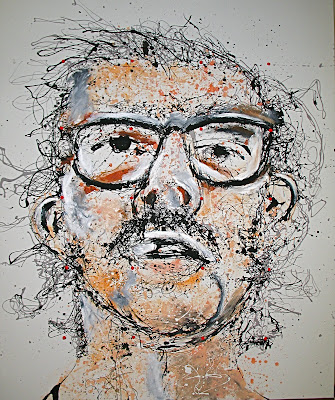"I had a good run"

This is the finished version of "The Annotated Bear."
By my count, 189 annotations, the vast majority of which are in red--the color reserved for Bear employees.
The first annotation read: "Opening Bid: One Dimon." You can find it--although somewhat blurred (this is what happens when you drop a relatively cheap camera--the lens gets out of alignment and never goes back)--about two inches below the first T. The final annotation (inscribed around 3:30 p.m. yesterday) read: "I had a good run." You can find it between the first T and the A in "Annotated."
I figured it was as good a moment to stop as any.
Next up?
Do you remember this take on Chuck Close? Called "Close, but no Cigar"?

It's actually a spin-off version of the obscured box technique, but instead of obscuring a newly-painted square with tape or newspaper, I move a cardboard template (with a one-foot square cut in the middle) around the canvas. While I'm painting any given square, the cardboard is obscuring what is next to me. Get it? Good, because it gets more complicated.
When all the squares in the first layer are finished, I then take a tube of paint and squeeze a goober (technical term) onto each of the points where the pencil lines that form the original grid intersect--the corners of the squares, if you get me.
Then I revisit the painting again for a second layer. Except, instead of aligning the corners of my template with the corners of the grid (which is how I painted the first layer), I execute the second pass by placing each newly-painted dot in the center of the template's open square.
This is what it looked like after I had completely finished the first gray layer and was beginning the second black layer.

This then creates several geometric outcomes: First, it means there's a primary grid (the one inscribed by the borders of the 30 one-foot squares that comprise the canvas). The second pass then creates a secondary grid (of which there are only 20 squares), which floats atop the primary grid. And finally, the lines created by both the primary and secondary grid means that there are actually a series of 6-inch squares floating all over the damned thing as well.
Man, do you really expect anybody to follow that?
Yeah. Why not?
'Cause it's whack, man. Not everybody got an A in geometry.
I don't think it's really geometry as much as quantum physics.
Why don't you just tell us who you're gonna paint next?
I'm thinking maybe all three Kennedy boys--Jack, Bobby and Ted.
Now that's cool.
Yes. I'm feeling that it is.

0 Comments:
Post a Comment
<< Home